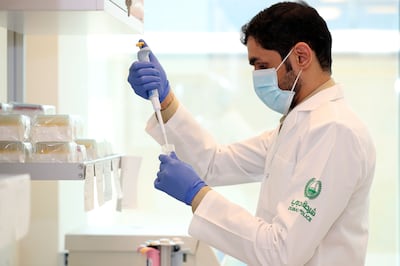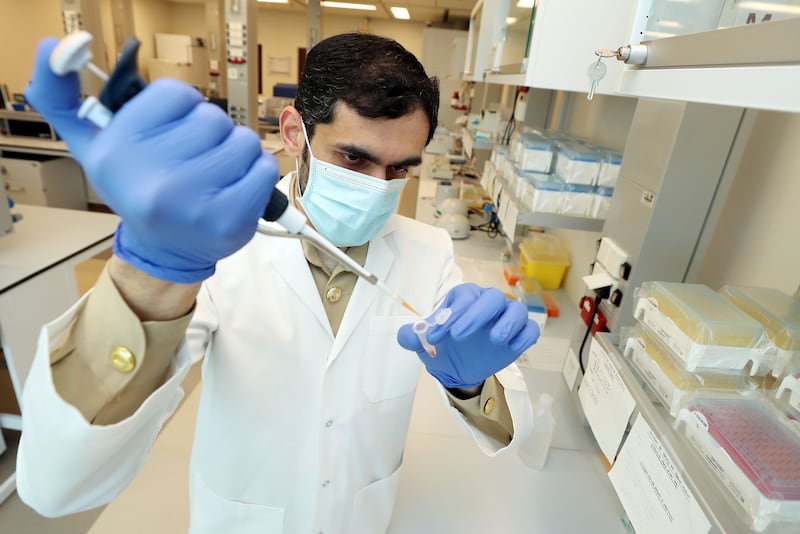Dubai Police have embraced cutting-edge forensics to solve cold cases, bring closure to families and ensure criminals have nowhere to hide from justice.
Rapid developments in how scientists test DNA at crime scenes are playing an increasingly crucial role in solving crime.
From collecting DNA in air particles from air conditioning units, to the latest Y-chromosome testing kit to eliminate suspects from inquiries, methods at the disposal of criminologists are changing almost weekly.
At the Training and Development Department at Dubai Police, scientists are putting years of research into practice, placing new tools into the hands of officers to solve cold cases that go back years and bringing peace to families of loved ones lost in the distant past.
Lt Col Dr Rashid Alghafri is at the heart of research and development at Dubai Police, and has helped to shape some of the most important evidence testing protocols used in recent years.
The science behind fighting crime

Dr Alghafri's work at Dubai Police, in co-operation with Beijing Microread Genetics, to develop a microreader capable of testing 26 DNA biomarkers has proved more than 99 per cent effective in identifying male perpetrators of serious crimes.
It has become a vital tool, when used with other criminological methods, to build an effective case against suspects.
“There is a challenge in actually separating the male part of genetic material from the female, specifically in sexual assault cases,” said Dr Alghafri, who leads a 600-strong team of experts at the International Centre for Forensic Science division of Dubai Police.
“Male DNA profiling started back in 1992 when four different Y-chromosome markers could analyse such samples.
“It was a very powerful tool for exclusion, but not for inclusion.
“Since then, there has been a huge development in this field as scientists added more markers on the Y-chromosome to increase the discrimination capacity.
“Where DNA and fingerprinting are tools used to identify individuals, we need to be very accurate.
“If we have a sexual harassment case, if we're going to put someone behind bars, we must be 100 per cent sure.”
DNA profiling
Extracting 26 Y-STR markers from a male chromosome using the analysis kit designed by Dr Alghafri eliminates male family members from the sample with a far greater degree of certainty, improving the quality of evidence available to police investigators.
The amplification kits are now used around the world at crime scenes, mass graves and natural disaster sites to identify victims, as well as perpetrators.
“We have tried the tool in the identification of those in mass graves in Slovenia and Serbia from World War Two,” said Dr Alghafri.
“The challenge is you have all of these skeletons in one place who you can separate using traditional identification.
“However, when it comes to brothers and people from the same male lineage or with close male relatives, it becomes challenging.
“But when we use this tool, we can say: those are your sons who were victims of this war.
“It can give families closure, to identify missing people.”

Similar techniques were first used in 2016 by Dubai Police to identify a headless, handless body buried in Al Warqa desert and discovered by a municipal worker.
Without knowing who the body was, police were unable to begin searching for a perpetrator.
A skin sample with DNA extracted from the victim was analysed, revealing Asian heritage, later narrowed down to the Philippines.
A cross-reference with missing person reports helped police identify the body as 46-year-old Maria Normita de Lima, a housekeeper, whose employers assisted police by providing DNA samples from her possessions confirming a genetic match.
Police then got to work analysing male DNA found on the victim.
“We found male DNA hidden under this sample, which gave us 44 different markers and unique identifications,” said Dr Alghafri.
“It gave us a full profile for a male perpetrator and CID could start their investigation.
“When they brought in their suspect, they could identify that individual with a connection to the body.”
Ms de Lima's nephew later admitted to killing the mother of two over a financial dispute.
Since then, the same techniques have evolved to help solve sexual assault crimes.
Cold case solved
A cold case left unanswered for eight years was finally solved when DNA evidence taken from a rape victim’s clothes led police to a man whose genetic information was held on their database.
While he was not held responsible, his brother who had recently died in a traffic accident was found to be the culprit after DNA sampling of his clothes.
Police eliminated the surviving brother from their investigation thanks to the Y-chromosome test developed by Dr Alghafri.
Soon, police may be able to look for clues hidden in airborne droplets found in cooling units.
A recent study by Flanders University looked at a new technique to record airborne DNA from crime scenes, otherwise wiped clean of fingerprints and other trace evidence.
Sample results were taken from four offices and four houses, at different times after cleaning.
Human DNA was collected on surfaces of AC units, with researchers now looking at the best time to collect post crime evidence in follow up studies.
The university’s senior forensic science lecturer, Dr Mariya Goray, said an average offender was unlikely to be able to prevent the release of their DNA into the environment, even with a good understanding of how forensic evidence is gathered.
Collection of trace DNA, when just a few human cells are collected, is commonly used in criminal investigations, but success rates are poor.
New technologies such as environmental DNA taken from solid surfaces, soil, water and air could help improve the field.
Dr Alghafri, who is also a professor at Murdoch University in Australia, Bond University in Dubai and UAE University in Abu Dhabi, said DNA testing will continue to evolve.
“The science keeps changing,” he said.
“We are here on the front line of crime, trying to solve these mysteries.
“When we get that eureka moment using these kind of tools, it means a lot.
“It’s the kind of success we are looking for, particularly in a cold case.”






